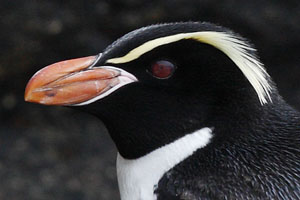Nest & Partner Selection:
Snares Crested penguins are thought to have relatively high fidelity to both nest sites and partners. Some colonies do however gradually move, since the guano expelled at nesting sites tends to damage the vegetation which serves to protect from the sun. Once vegetation cover is removed, colonies often move to nearby areas with intact cover. Other colonies are however located in barely vegetated rocky areas. Colonies are generally found at altitudes of up to 70 meters on relatively flat areas above the steep cliffs surrounding much of the islands. They may be over half a kilometer from the landing site. Crested penguins are extremely adept at climbing the steep cliffs surrounding the islands.
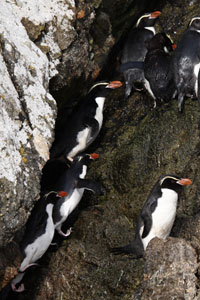 |
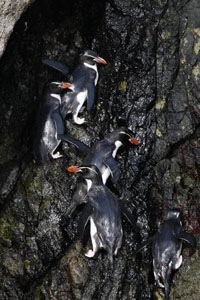 |
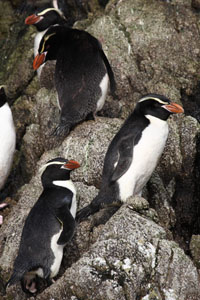 |
|
Snares Penguin Climbing Cliff
|
Snares Penguin Climbing Cliff
|
Snares Penguins on Cliff
|
Nests are relatively simple and often little more than a small hollow with a few stones and bits of vegetation or old feathers. The nests are often barely recognizable by the end of the creche phase.
Timing of Breeding:
On the main island (NE Isl.), males arrive at the breeding colonies shortly before females, at the end of August or in early September. The about 800 breeding pairs on the Western Chain Islands breed about 6 weeks later.
Laying and Incubation:
Two eggs are laid in late September / early October at the main breeding sites. Eggs are laid approx. 4-5 days apart, and hatch after 31-37 (mean 33.3) days of incubation (Warham 1974. J. Roy. Soc. NZ 4, p.63-108). The first-laid (A) egg has approximately 78% of the size of the second (B) egg which tends to hatch first. The eggs have the following mean parameters, although the level of dimorphism varies somewhat between clutches (Massaro and Davis 2005. Ibis 147, p.251-258):
|
A Egg |
B egg |
|
Length (cm)
|
68.6 |
73.8 |
|
Width (cm)
|
52.0 |
56.7 |
|
Volume (cm^3)
|
95.3 |
121.7 |
|
Mass (g)
|
102.1 |
130.4 |
The shells are about 0.45 mm thick in A eggs and 0.5 thick in B eggs, making up well over 10% of total egg mass. This is normal in penguins which are heavier than comparably-sized flying birds and thus need stronger eggs to prevent them being crushed during incubation. Interestingly, the Snares Penguin eggs are about 10 g heavier than those of the Fiordland penguins, even though Snares penguins are considerably smaller.
Incubation duties are shared. This includes a first shift of about 10 days when both parents alternate in foraging, followed by two shifts when one partner is absent for longer, the male first for an average of 11 days, followed by the female for about 6 days (Mattern et al., 2005. NZ J. Zool. 32, p.263-271 (Abstr.)).
Brood Reduction Mechanism:
As in other crested penguins, Snares Penguins display a brood reduction mechanism, meaning that they only rarely raise 2 chicks. The mechanism is similar to in the related Fiordland and Rockhopper Penguins. Macaroni, Royal and Erect-Crested Penguins display an even more extreme form of brood reduction. The reader is referred to the respective sections on these penguins for more detail.
Basically, whilst the A egg is laid first, the larger B egg generally hatches earlier (90% of cases) and gives rise to a larger chick. The B chick is consequently both larger and likely to be fed first. As a result, it gains a competitive advantage which generally results in partial or complete exclusion of the smaller chick from provisioning, resulting in eventual starvation thereof.
Many studies have addressed the hatching asynchrony of the two eggs in Eudyptid penguins. Several reasons may account for faster hatching of the second egg. These include the delayed onset of incubation (the brood patch is usually only fully developed 10-15 days after laying of the first egg), preferential incubation of the B egg, or biochemical / physiological differences between the eggs. Preferential incubation has been excluded as a mechanism acting in Snares Penguins (Massaro and Davis 2004. Behav. Ecol. Sociobiol. 56, p.426-434). The study showed that whilst as in other crested penguins the smaller A egg is generally found in the anterior position, this position could not be correlated to a lower incubation temperature. In fact, the optimum positioning to achieve high incubation temperatures in both eggs was to have the A egg in the anterior position, with the B egg behind. Interestingly, in clutches where the A egg was relatively large (i.e. egg dimorphism was low), its temperature was actually lower when in the anterior position. On the other hand, below average sized A eggs reached similar incubation temperatures irrespective of position. Since the eggs are not permanently in one position, large A eggs will suffer more temperature fluctuation than small ones. Consequently, high size-dimorphism correlated to the A egg hatching first, which occurred in about 10% of cases.
Nevertheless, in view of the laying interval, even if the A egg hatches first, it will have taken at least 3 more days since laying to hatch than the B egg, which generally hatches within a day of the A egg in these cases. Apart from the delayed onset of incubation, a further factor that likely explains preferential development of the B egg has been discovered in Snares Penguins (Massaro and Davis 2005. Ibis 147, p.251-258). The B eggs were found to have thicker shells, but these had significantly more pores i.e. mean of 83 per sq. cm compared to 76 in the A egg. The average size of pores (mean 21.5 micrometers; range 16-28) did not differ between A and B eggs. Pore density was shown to correlate with higher water vapour conductance which is taken as a measure of permeability of the egg to respiratory gases and water vapour, which is in turn a limiting factor for embryonic development. Hence, the B egg should develop faster. Further, it was found that the respective hatching dates of the A and B eggs within a clutch could be correlated to the relative pore diameters in the B eggs. In other words, B eggs that hatched before A eggs (i.e. the vast majority) had larger pores than B eggs hatching on the same day or even after the A egg.
Brood / Guard Phase:
After hatching, brood / guard duties are entirely the responsibility of the male parent. The female goes on short daily foraging trips during this period to provision the chicks. The brood / guard phase lasts about 3 weeks, towards the end of which chicks may be first observed wandering away from the nest. During the guard phase, the chicks become thermoemancipated as their metabolism increases and their down thickens. This is a prerequisite for chicks to be able to be left unattended.
Creche:
Creching usually occurs after about 3 weeks, and creches of up to about 30 chicks are formed. Both parents feeds the chicks during this phase, although feeding by females is apparently more frequent, possibly as males have to make up for the weight loss occurring whilst at the nest during brood / guard. When parents return from their foraging trips, they tend to progress rapidly to their nests whilst adopting a "slender walk" posture which serves to reduce aggression from nearby nesting birds. On average, within 3 sec of arriving at their nests, adults would call their chicks and these would usually respond by quickly looking around, calling and scurrying towards the nest.
Acoustic Parent-Chick Recognition:
Parent-chick recognition appears to be largely acoustic. This was determined based on visual observations and playback experiments (Proffitt and McLean 1991. Bird Behav. 9, p.103-113). Not only are chicks able to recognize parents, but parents are evidently able to recognize their chicks too. Mutual recognition is important so that the parent can feed its own chick and also so that chicks do not waste energy and risk injury by begging for food from a non-parental bird. Only rarely will chicks be fed "accidentally" by non-parental birds, and it is possible, but yet to be addressed, that these interactions involve birds with similar calls.
It is thought that the chicks must learn parental call recognition during the guard stage when parents perform the mutual display involving braying and trumpeting calls as part of the nest relief ceremony. Playback of recorded trumpeting calls was much more successful at eliciting a positive recognition response when the own parents calls were played to chicks. It appeared that chicks towards the end of the creche phase were better at discriminating parental and non-parental calls. The role of nest location in recognition is unclear, although it seemed that chicks were slightly confused when the call came from an unexpected direction (i.e. away from nest site), since they then often looked back and forth between speakers and nest site.
The exact composition of the call was not analysed in the study, but is likely similar to the call in other crested penguins. For example, adult Macaroni Penguins make about 1.75 sec long calls, made up of a long first part (syllable), followed by a second similar-lengthed part consisting of 5-30 (average 12.84) short syllables (Searby et al., 2004. Animal Behav. 67, p.615-625) of which the 1st are repetitive short syllables, with the final 2 syllables being marginally longer. The tempo of the syllables, together with their harmonic content, make the signal distinctive, i.e. Macaroni Penguins have a double vocal signature. The call is basically like that of the Rockhopper Penguin (0.45 sec), yet the individual syllables are more distinctive in the Macaroni penguin (Searby and Jouventin 2005. J. Avian Biol. 36, p.449-460). Both Rockhopper and Macaroni calls, and probably Snares Penguin calls, are less complex than the double vocal signature of Aptenodytes penguins (e.g. Emperor), but more complex than the purely harmonic system in Pygoscelis penguins (e.g. Adelie, Gentoo).
Fledging:
Fledging age is about 11 weeks. At this stage, the chicks brownish down has been replaced by a Juvenile plumage adapted to life in the ocean. Juveniles can however still be easily recognized since they have far shorter crests than adult birds. Juveniles tend to assemble at the coast and may hesitate there for a while before finally departing. Adult birds are only thought to start breeding at an age of about 6 years. Only few Snares Penguins appear to reach this age, since only about 50% of birds are thought to survive per year for the first few years of their lives, with the lowest survival rates probably occurring in the first year.
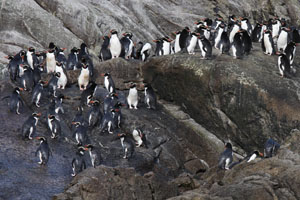 |
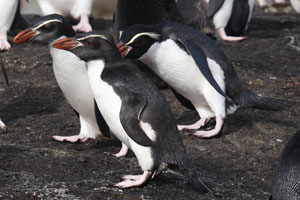 |
|
Snares Penguin Assembled on Rocks near Sea
|
Two Juveniles (note shorter crests) & One Adult
|
Moult:
After breeding, adult birds spend from 4-6 weeks foraging in order to increase body weight for the energetically demanding moult. Moulting occurs at the nesting sites during March / April, although some adult birds have been reported on land at other sites, distant from the Snares. These may largely be non-breeding birds, which otherwise moult at the periphery of colonies or on rocks near the sea.
|
